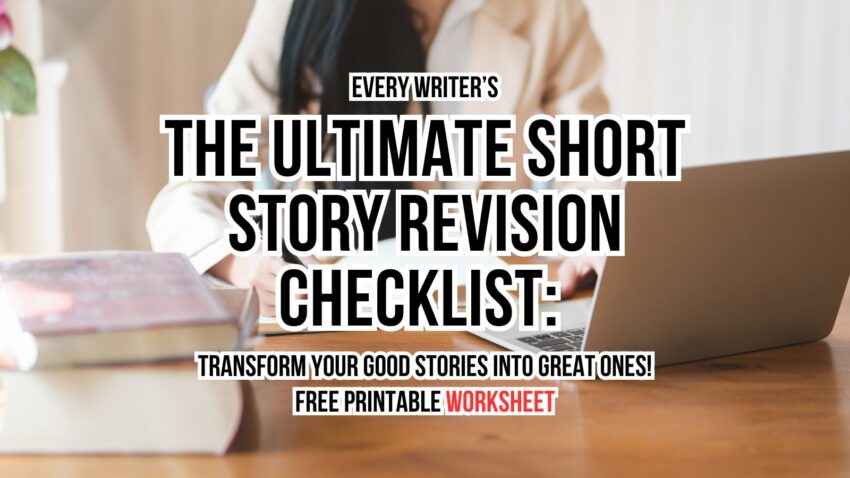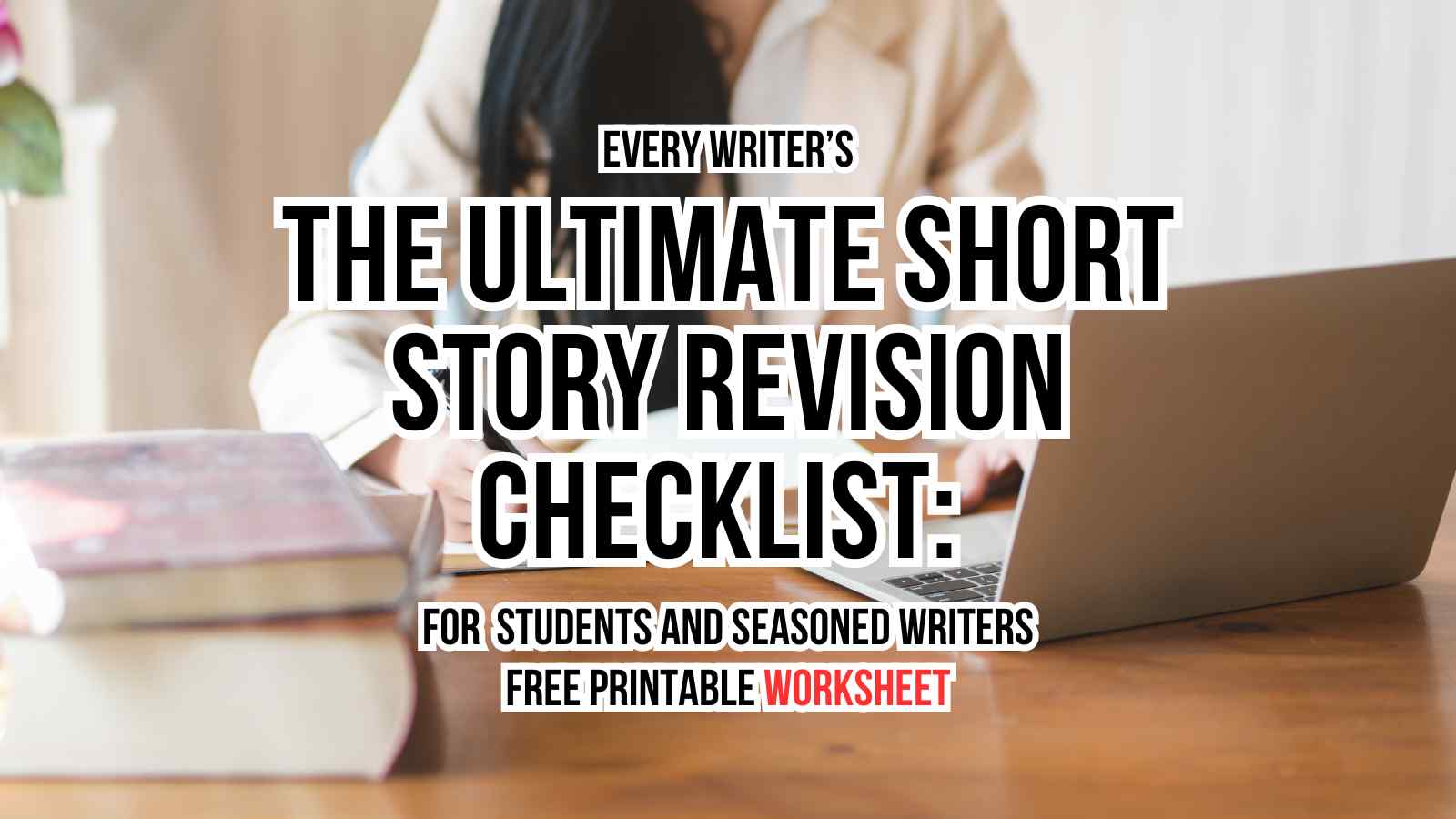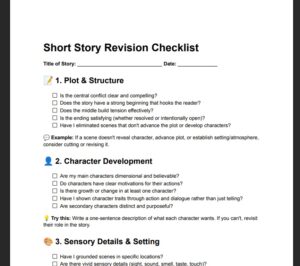The Ultimate Short Story Revision Checklist: For Students and Seasons Writers
Oh my god, revisions have always been my nightmare. Short story revisions have been crippling to me, if I’m honest. I once wrote a 30-page story just to find in revisions it needed to be in a completely different point of view. After many years, I’ve finally found a more systematic way to go through my stories. It’s not thrilling to me, but it makes the process a little less painless.
I wanted to put together this revision guide for others who might struggle like I do. Whether you’re writing stories for yourself, a classroom assignment, or hoping to get published someday, these revision strategies might help take some of the sting out of editing. God knows we need all the help we can get when facing that messy first draft.
These eight essential elements could spark some actually useful ideas – from tightening your plots to making characters feel like real people. Maybe they’ll even push you to try something weird that takes your writing in unexpected directions. Students and classroom writers might find some relief here too.
So grab your red pen and maybe a strong drink if needed. These revision strategies below won’t make editing your favorite activity (if that’s even possible), but they could help take your stories from “what was I thinking?” to “hey, this isn’t half bad” with a bit less suffering along the way.
1. Plot & Structure: Building a Compelling Framework
The skeleton of your story needs to be strong enough to carry readers from beginning to end without losing their interest! During revision, examine your plot with the critical eye of a master architect:
Is the central conflict clear and compelling?
Every great story revolves around a conflict that matters. Your protagonists should want something badly, and something powerful should stand in their way. During revision, highlight the sentences that establish your core conflict. If you can’t find them easily, your readers won’t either!
When revising, ask yourself: Will my readers be able to identify the main conflict? If not, you might need to clarify.. Remember, even the most complex literary masterpieces can be boiled down to clear conflicts: human vs. nature, character vs. self, protagonist vs. antagonist.
Does the story have a strong beginning that hooks the reader?
In today’s fast-paced world, you have mere seconds to capture a reader’s attention! Your opening should be like a velociraptor pouncing on its prey – swift, surprising, and impossible to escape from!
Look at your first paragraph critically. Does it raise immediate questions? Create tension? Introduce an intriguing character or unusual situation? If not, try this radical revision technique: Delete your entire first paragraph and see if the story starts with more energy. Often, our true beginnings are hiding on page two after we’ve cleared our writerly throats!
Does the middle build tension effectively?
The middle of your story should be like climbing a mountain – steadily increasing in tension and stakes as readers approach the summit. Each scene should ratchet up complications or deepen character development.
During revision, map out your story’s tension on a simple graph. If you notice long flat sections or dips in tension, those are prime targets for revision. Cut scenes that don’t advance the plot, combine characters who serve similar functions, or introduce a compelling new complication.
Is the ending satisfying (whether resolved or intentionally open)?
Endings should feel both surprising and inevitable – a delicate balance that comes through careful revision. Whether you tie everything up neatly or leave some threads intentionally open, readers should feel the journey was worth their time.
Ask these revision questions: Does your ending resolve the primary conflict established at the beginning? Does at least one character experience meaningful change? Have you avoided introducing brand new elements in the final scene that weren’t set up earlier?
Have I eliminated scenes that don’t advance the plot or develop characters?
Every scene in your story should earn its place by serving at least one of these purposes:
- Advancing the main plot
- Developing important characters
- Establishing crucial setting/atmosphere
- Revealing essential thematic elements
During revision, evaluate each scene against these criteria. If a scene doesn’t check at least one box, it’s a prime candidate for cutting – no matter how beautifully written it might be! Remember, sometimes our most gorgeous prose needs to be sacrificed for the greater good of the story.
How This Revision Worksheet Will Revolutionize Your Writing Process!
So you’ve created your first draft – congratulations! Now the real magic begins with revision, and our comprehensive Short Story Revision Checklist is about to become your new best friend in this transformative process. Think of this worksheet as your personal writing coach, guiding you through each critical element of story craft with pinpoint precision!
The Power of Systematic Revision
Have you ever stared at your story draft, knowing something wasn’t working but feeling completely lost about where to start fixing it? That’s where our revision worksheet comes to the rescue! By breaking down the revision process into eight essential categories, you’ll transform an overwhelming task into manageable steps that build on each other.
Targeted Problem-Solving
Just like a doctor uses a systematic approach to diagnose a patient, this worksheet helps you identify exactly what’s ailing your story. Rather than making random changes and hoping they improve the overall story, you’ll target specific elements:
- Is your plot sagging in the middle? Section 1 helps you identify and fix structural weaknesses!
- Are your characters falling flat? Section 2 guides you through dimension-building techniques!
- Is your setting forgettable? Section 3 transforms bland locations into vivid story worlds!
Each category contains specific questions that shine a spotlight on common problems, making them impossible to ignore. No more vague feelings that “something’s not working” – you’ll know exactly what needs fixing and have concrete strategies to address each issue.
From Intuition to Intentional Craft
Many writers rely solely on intuition during revision, but this worksheet helps you develop the analytical skills of a master editor. You’ll learn to see your story through different lenses – examining dialogue effectiveness separately from pacing concerns, or thematic depth apart from character development.
The step-by-step approach transforms you from someone who simply “feels” when writing works to someone who understands the mechanics behind successful storytelling. This doesn’t replace your creative intuition – it enhances it by giving you specific tools to implement your vision more effectively!
Documentation of Growth
The worksheet isn’t just a one-time tool – it becomes a record of your evolution as a writer! By keeping completed worksheets with each story draft, you’ll:
- Track which story elements consistently need improvement
- Recognize patterns in your writing strengths and weaknesses
- See tangible evidence of your growth as you master new techniques
- Develop personalized revision strategies based on your unique challenges
Many writers find it thrilling to look back at early worksheet notes after several revisions. There’s nothing more satisfying than seeing how far your story has come through deliberate, focused revision!
Classroom & Writing Group Magic
If you’re teaching creative writing or participating in a writing group, this worksheet creates a common language for discussing stories constructively. Rather than vague feedback like “I just didn’t connect with it,” reviewers can point to specific elements:
“Your character motivations in section 2 need clarification – I wasn’t sure why Alex decided to enter the haunted house after being so afraid earlier.”
For teachers, the worksheet simplifies assessment by providing clear revision criteria. Students learn that writing isn’t about mysterious talent but specific skills they can develop through practice and awareness.
Making the Most of Your Worksheet
To get maximum value from this revision tool, approach it with the right mindset:
- Complete a full draft first – Don’t try to perfect each element as you write. Get the complete story down, then use the worksheet for revision.
- Be brutally honest – The worksheet only works if you’re willing to acknowledge weaknesses in your beloved draft. Remember, even Hemingway said, “The first draft of anything is garbage!”
- Focus on one section at a time – Don’t try to fix everything at once. Start with plot and structure, then move through each category systematically.
- Keep notes in the margins – Document specific pages or paragraphs that need attention within each category.
- Celebrate your discoveries – Finding a problem is the first step to fixing it! Each issue you identify is an opportunity to strengthen your story.
If you are like me and are haunted by revisions this worksheet will help. It makes it a little more bearable, but I wont’ say it’s fun. So dive in. Grab your worksheet, sharpen your red pen, and dive into the revision process with confidence and excitement. Your future readers will thank you!
—-Download the Worksheet here—-
Please let us know in the comments if you had any trouble with the downloads. Also let us know if this worksheet is helpful!
- THE MORAL GHOST STORY: Reviving a Lost Christmas Tradition - December 2, 2025
- The Last 6 Words of ’25: Holiday Memoir Contest - December 2, 2025
- My 31 Days of Halloween Horror Movie Marathon 2025 - October 3, 2025



Yes I need this checklist. No I don’t want to admit it to myself. Thanks for making something useful.